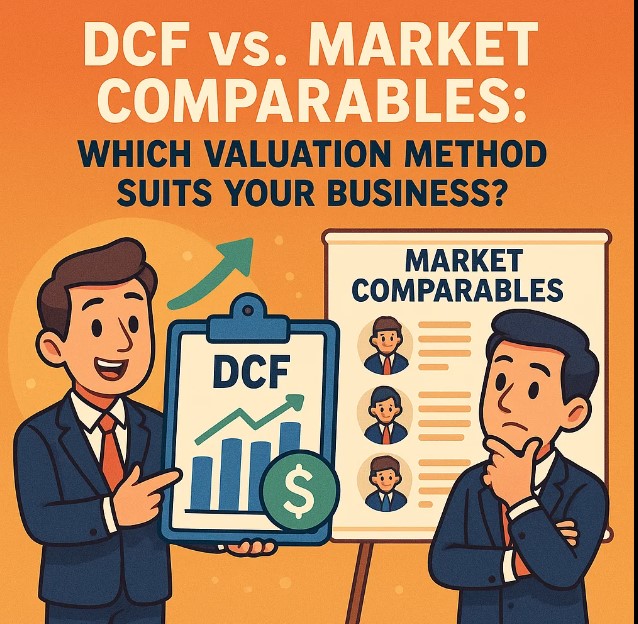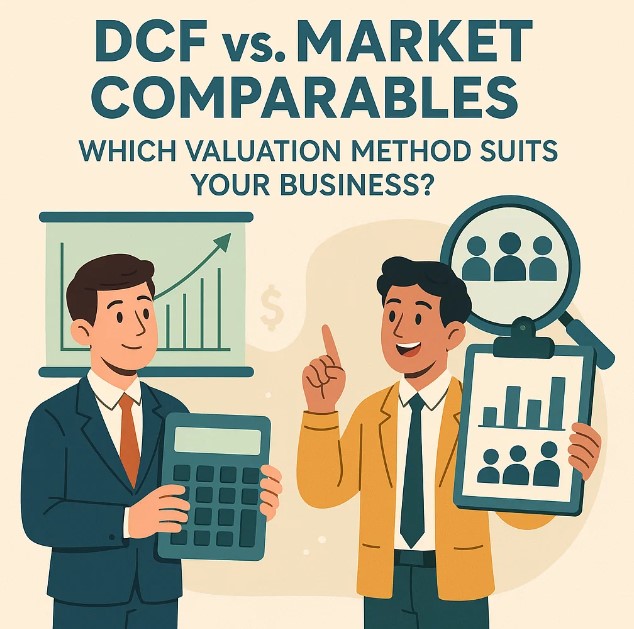
DCF vs. Market Comparables: Which Valuation Method Suits Your Business?
When it comes to determining the value of a business, the two most widely used methods are Discounted Cash Flow (DCF) and Market Comparables. Each of these methods has its own strengths and weaknesses, and the choice between them often depends on the specific characteristics of the business being valued, the industry it operates in, and the purpose of the valuation.
Valuation is more than just numbers—it's about understanding the story behind your business. Whether it's the future-focused precision of DCF or the market-driven perspective of Comparables, the right method can reveal your company’s true value. Choose wisely to unlock your business’s potential.
What is Discounted Cash Flow (DCF) Valuation?
The Discounted Cash Flow (DCF) method is a valuation technique that calculates the present value of a business based on its projected future cash flows. The idea is that the value of a company today is equal to the sum of all its future cash flows, adjusted for the time value of money. In other words, the method discounts the company’s expected future cash flows to reflect their value today.
How DCF Works
- Project Future Cash Flows: The first step in DCF valuation is to estimate the company's future cash flows, typically for the next 5 to 10 years. These projections are based on historical performance, industry trends, and growth assumptions.
- Choose a Discount Rate: The next step is to determine an appropriate discount rate, often referred to as the Weighted Average Cost of Capital (WACC). This rate reflects the company’s cost of capital, factoring in both debt and equity costs.
- Calculate the Present Value of Cash Flows: Using the discount rate, the future cash flows are discounted to their present value. This is typically done using the formula:
DCF Value = Σ Cash Flow in Year n / (1 + r)^n - Terminal Value: After the projection period, a terminal value is calculated to account for the business’s value beyond the forecast period. This is then discounted back to the present.
- Sum of Cash Flows and Terminal Value: The sum of the discounted cash flows and terminal value gives the total business valuation.
Pros of DCF Valuation
- Forward-Looking: DCF is based on future projections, making it highly reflective of a company's growth potential.
- Customizable: You can tailor assumptions to reflect the unique factors of the business being valued.
- Intrinsic Value: DCF provides an intrinsic valuation, which does not depend on external market conditions or comparable businesses.
Cons of DCF Valuation
- Data Sensitivity: DCF heavily relies on accurate forecasts of future cash flows. Even small changes in these assumptions can lead to significant variations in the final valuation.
- Complexity: The method requires a deep understanding of financial modeling and the company’s future performance, which can be difficult to predict accurately.
What are Market Comparables?
The Market Comparables method, also known as the Comparable Company Analysis (CCA), values a business by comparing it to other similar companies that have been recently valued in the market. This method uses financial ratios or multiples to gauge how much a business is worth in relation to similar companies in the same industry.

How Market Comparables Work
- Identify Comparable Companies: The first step is to identify companies that are similar in size, industry, and market. This is done by selecting businesses that operate in the same sector and are of comparable scale.
- Select Valuation Multiples: Common multiples include the Price-to-Earnings (P/E) ratio, Enterprise Value-to-EBITDA (EV/EBITDA), and Price-to-Sales (P/S). These multiples are based on the market value of comparable companies.
- Apply Multiples to Your Business: Once you have the multiples of comparable companies, you can apply them to your company’s financials to estimate its market value. For example, if a comparable company has a P/E ratio of 15 and your business’s earnings are $1 million, your company’s value would be approximately $15 million.
Pros of Market Comparables
- Simplicity: Market comparables are relatively simple to apply and understand, as they rely on readily available market data.
- Benchmarking: This method provides a clear market perspective, allowing you to compare your business’s valuation with that of similar companies.
- Widely Accepted: It is a commonly used method in investment banking, mergers, and acquisitions because of its objectivity and ease of comparison.
Cons of Market Comparables
- Market Dependence: The method is influenced by market conditions. If the market is overvalued or undervalued, your business’s valuation may be skewed accordingly.
- Limited by Availability: The availability of truly comparable companies can be limited, especially for niche industries or unique businesses.
- Lack of Precision: Since this method is based on averages or multiples from other companies, it may not fully account for the specific nuances of your business.
Which Method Is Right for Your Business?
The choice between DCF and Market Comparables depends largely on the context of the valuation.
- Use DCF When:
- Your business has stable and predictable cash flows.
- You have a strong understanding of the company’s future prospects and can make informed projections.
- You’re valuing a company that is not similar to others in the market (e.g., a startup or a unique business model).
- Use Market Comparables When:
- Your business operates in a mature industry with many similar companies.
- You are looking for a quick and market-driven valuation.
- You want to compare your business to industry peers to gauge how it is valued in the market.
Conclusion
Both Discounted Cash Flow (DCF) and Market Comparables are valuable tools in business valuation, but they serve different purposes. The DCF method provides a deep, intrinsic view of a company’s worth based on future expectations, while Market Comparables offer a snapshot of how your business stacks up against its competitors. Often, professionals use both methods in conjunction to gain a well-rounded perspective on a business’s value.
Choosing the right method depends on your business’s characteristics, the availability of data, and the specific needs of your valuation. Whichever method you choose, it’s essential to understand the assumptions behind the numbers and use them in the right context for the most accurate and relevant valuation.
Which valuation method—DCF or Market Comparables—best reflects your business's true worth?
